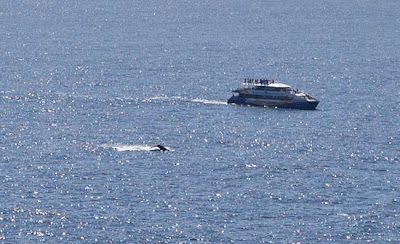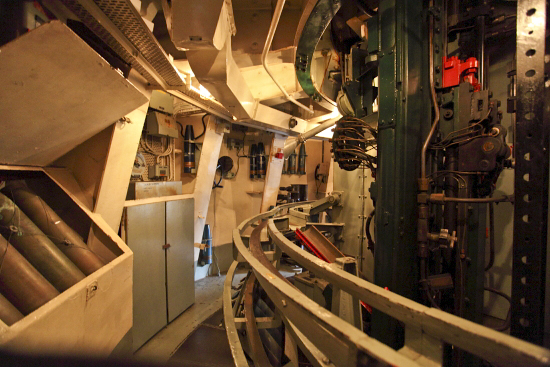Today I visited the Australian National Maritime Museum, which is at Darling Harbour, Sydney.
Australians are closely linked to the sea through commerce, defense, exploration, adventure, sport and play. Our oceans and waterways have influenced our development...and who we are. The museum captures these themes with fascinating artifacts, lively exhibitions, fun activities and even the chance to board ships and experience life on the water.
HMAS Vampire (II)
 HMAS Vampire (II) commissioned at Sydney on 23 June 1959
HMAS Vampire (II) commissioned at Sydney on 23 June 1959
under the command of Captain Eric J. Peel.


HMAS Onslow, Oberon class submarine, 1968
Onslow was commissioned during the Cold War, a tense time that called for a submarine to watch, listen and collect information without detection. The most secretive work was tracking Soviet submarines moving into the Arabian Gulf from Vladivostok via the Coral Sea and the Great Australian Bight.
With five other Oberons, Onslow gave the Royal Australian Navy a formidable submarine force. The motto of the navy's submarine arm is "Strength, silence, surprise". This explains many of Onslow's characteristics, including:
- a diving chamber for Special Forces to leave the boat for covert operations
- a gash ejector containing weighted rubbish (gash) bags. When ejected, the bags sink to the ocean floor so no debris floats to give away the submarine's position
- soundproofing on all equipment to make Oberons one of the quietest submarines ever built.
Onslow has travelled the equivalent of more than 16 times around the world, serving Australia with quiet distinction for 30 years.

Dutch Jacht Duyfken 1606
In April 1606 Duyfken, the Dutch East India Company ship made the first recorded European visit to the Australian continent, landing on the Cape York Peninsula. Duyfken means 'Little Dove' and the little scout ship or jacht was commanded by Willem Janszoon who made the first chart of mainland Australia, and the first landing by Europeans. The reconstruction was built in Western Australia, launched in 1999, and has re-enacted Janszoon's voyage of discovery.






Bareki, 1962 tugboat
This sturdy work boat was built to a World War II Australian tugboat design at Goat Island shipyard, Sydney Harbour. Bareki (thought to be Aboriginal for 'water') was the last timber tug in service with the Maritime Services Board. It now works for the museum, handling vessels in the National Maritime Museum collection.
Cape Bowling Green lighthouse
By 1874 many ships had run aground at Cape Bowling Green. This low sandy spit south of Townsville, Queensland, was in dire need of a lighthouse to help ships serving north Queensland ports. The lighthouse was built from local hardwood and clad with iron plates imported from Britain. Staffed by a keeper and three assistants, it was moved twice when threatened by the sea. When an automatic acetylene light was installed in 1920 (operated by a sun valve), the lighthouse was de-staffed. In 1987, it was replaced by a modern tower. It was transported to the museum in 1994, re-erected on our North Wharf and fitted with the type of clockwork and kerosene mechanism used in 1913.


Barque James Craig, 1874
The barque James Craig was built by Bartram, Haswell & Co. in Sunderland, England in 1874. Originally named Clan Macleod, her maiden voyage was to Peru.
For 26 years she plied the trade routes of the world carrying general cargoes during which period she rounded Cape Horn 23 times. In 1900 she was purchased by Mr J J Craig of Auckland and was used on trans-Tasman trade routes as a general cargo carrier. In 1905 she was re-named James Craig and then a short six years later, in 1911, she was laid up because increasing competition from steam ships made sailing vessels uneconomical. She was then stripped and used as a copra hulk in New Guinea. After the First World War there was an acute shortage of cargo ships. This gave James Craig a new lease of life after being towed from New Guinea to Sydney for re-fitting.
Her return to service was brief because in 1925 she was reduced to a coal hulk at Recherche Bay, Tasmania. In 1932 she was abandoned and became beached after breaking her moorings in a storm. She remained beached until 1972 when volunteers from the Sydney Heritage Fleet re-floated her. In 1973 she was towed to Hobart where temporary repairs were carried out. She was towed to Sydney in 1981 and restoration work commenced. The James Craig's restored hull was re-launched in February 1997.
Off Sydney Heads, on a glorious summer day in February 2001, she hoisted all her 21 sails for the first time in nearly 80 years and is now fully operational.










 It was interesting watching this mother and calf get very close to the cliffs
It was interesting watching this mother and calf get very close to the cliffs























































































































